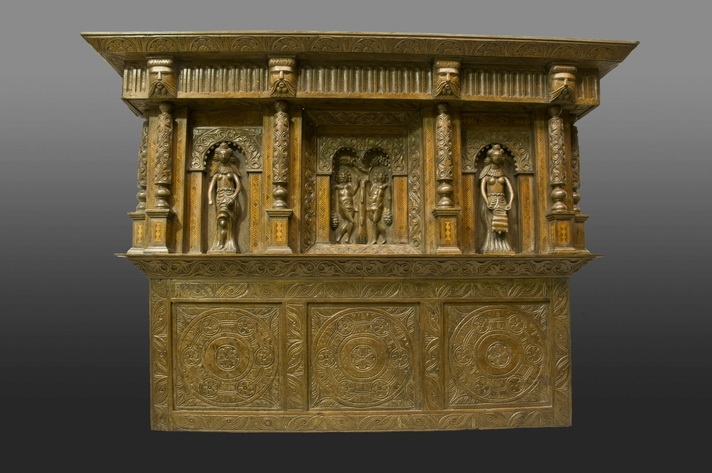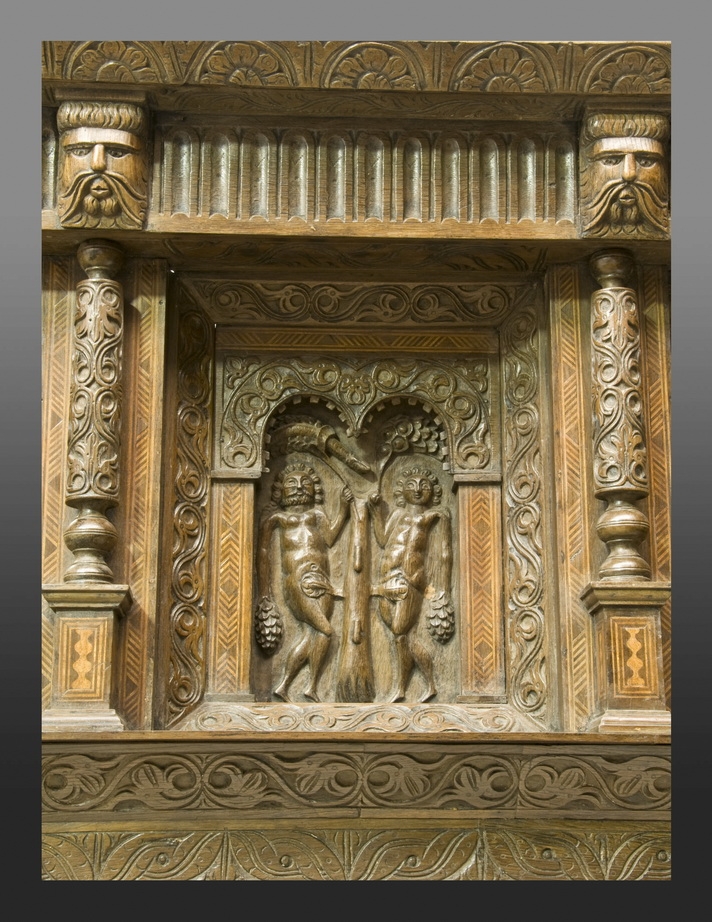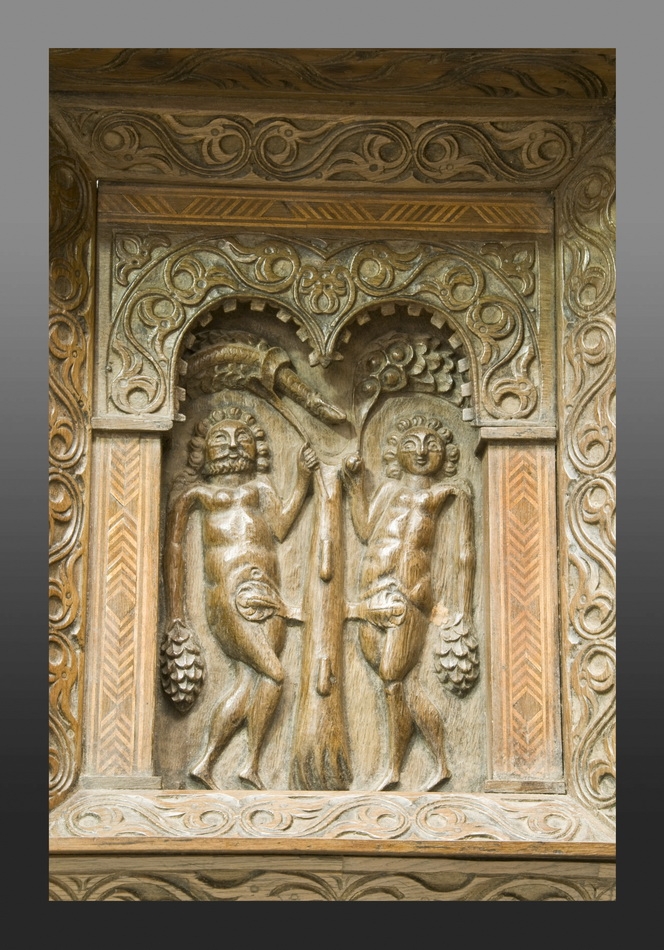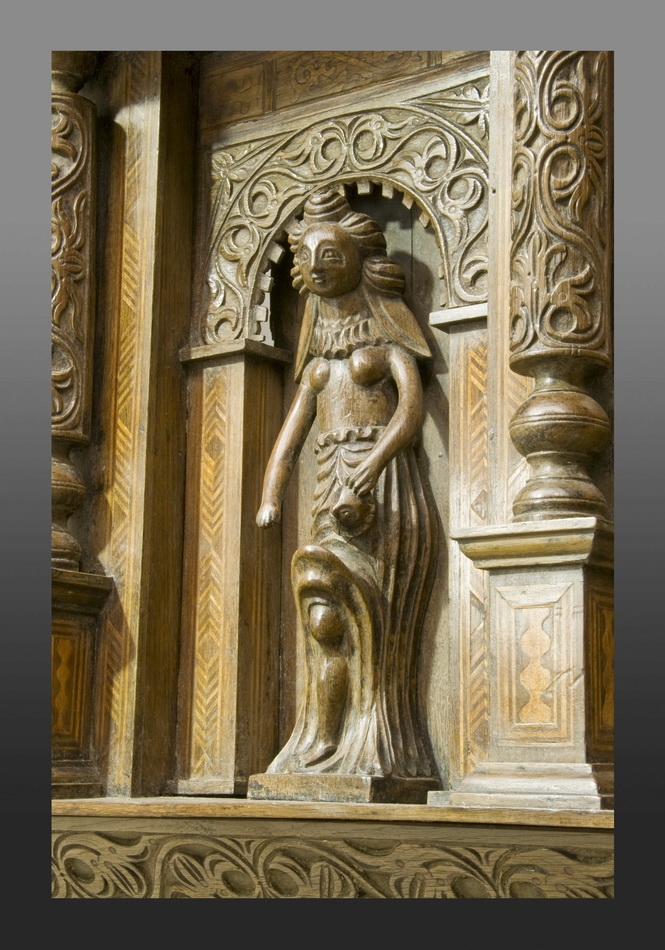James I joined oak overmantel
1610
Kent, England
W 70" × H 51" × D 12.5"
Stock # MARH0178
SOLD
Discovered in Kent, this elaborately conceived and meticulously executed joined oak overmantel exhibits the range of graphics employed by the high level of early seventeenth-century joiners serving non-urban clients. Its schema of ornament encompasses relief carved, applied, turned, and figurative techniques, as well and inset, contrasting woods (holly and what appears to be imported mahogany). The upper tableau, set behind turned and carved columns supported by inlaid plinths, consists of three niches. Each niche is fronted with applied carved and inlaid classicized arcades and contains highly stylized anthropomorphic figurals modeled in three dimensions. Carved upon a recessed panel, the central figural group represents Adam and Eve flanking the trunk of an abstract tree which splits into two foliated limbs, one of which bears apples, while the other is inhabited by a decidedly phallic-looking serpent. Adam (on the proper right) grasps a limb with his left hand. Eve (on the proper left) holds an apple with her right hand. The downward extended free arms of both figures terminate in vegetal-forms executed with the same scaled foliage as the limbs of the tree they do not grasp the foliage, their arms become the foliage. A three-dimensionally modelled panel carved by the same shop, or even the same hand, is illustrated Victory Chinnerys, Oak Furniture: The British Tradition, pg, 173, fig. 2:174, and appeared as lot 520 in the sale catalogue of the Rous Lench collection, vol. 2, Sothebys, 3-4, 7, 1986. The proportions, execution, and overall layout of the figural grouping on the Rous Lench panel reflect the same conceptual and technical approach as the carving of the overmantle. Both pairs of figures share the same position relative to the central tree; their musculature and hair are modelled in the same manner, and their genitals are concealed by conveniently sprouting leaves. Most tellingly, the free arms of the Rous Lench panel figures also terminate in vegetal appendages, without any indication of human hands. Also, a vertically extended branch at the centre-point of the Rous Lench panels ends in scaley leafage of the type that appears on the overmantle.
While, the Adam and Eve grouping are carved upon a drop ground and set back from the viewer, the flanking figurals are prominently freestanding. Two bare-chested women are set slightly in front of their respective niches. The woman on the proper right holds a severed human head in her left hand, while her counterpart carries a form that appears to be a footed cooking pot with both hands. Although speculative, iconographic analysis yields a connection to a passage from the Old Testament. Chapter 6 in volume two of the Book of Kings relates an encounter between King Saul and a Samarian woman, during which Sauls son is boiled and eaten. Verses 28-29 are as follows: (6:28) And the king said unto her, What aileth thee? And she answered, This woman said unto me, Give thy son, that we may eat him to day, and we will eat my son tomorrow; (6:29) So we boiled my son, and did eat him: and I said unto her on the next day, Give thy son, that we may eat him: and she hath hid her son. The question that remains, one that will probably never be answered, is why this particular and unusual juxtaposition of Biblical imagery was selected by either patron or artisan.
Very similar overmantles, possibly by the same shop, can be seen in Godinton House, Ashford, Kent.




